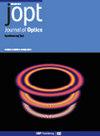用于先进成像系统的矢量自适应光学系统
IF 2.7
4区 物理与天体物理
Q3 OPTICS
引用次数: 0
摘要
矢量自适应光学(V-AO)是一种尖端技术,它将传统的自适应光学扩展到矢量域,包括光学系统的偏振和相位反馈校正。然而,以往的矢量自适应光学方法侧重于点校正。在这封信中,我们将这种 AO 方法扩展到成像领域。我们展示了 V-AO 如何使像差成像系统受益,不仅增强标量成像,而且提高矢量信息的质量。我们提出了两个重要标准,即矢量精度和均匀性,并在实践中用来评估校正的性能。这些实验验证为 V-AO 技术及其应用的实际成像铺平了道路。本文章由计算机程序翻译,如有差异,请以英文原文为准。
Vectorial adaptive optics for advanced imaging systems
Vectorial adaptive optics (V-AO) is a cutting-edge technique extending conventional AO into the vectorial domain encompassing both polarization and phase feedback correction for optical systems. However, previous V-AO approaches focus on point correction. In this letter, we extend this AO approach into the imaging domain. We show how V-AO can benefit an aberrated imaging system to enhance not only scalar imaging but also the quality of vectorial information. Two important criteria, vectorial precision and uniformity are put forward and used in practice to evaluate the performance of the correction. These experimental validations pave the way for real-world imaging for V-AO technology and its applications.
求助全文
通过发布文献求助,成功后即可免费获取论文全文。
去求助
来源期刊

Journal of Optics
OPTICS-
CiteScore
4.50
自引率
4.80%
发文量
237
审稿时长
1.9 months
期刊介绍:
Journal of Optics publishes new experimental and theoretical research across all areas of pure and applied optics, both modern and classical. Research areas are categorised as:
Nanophotonics and plasmonics
Metamaterials and structured photonic materials
Quantum photonics
Biophotonics
Light-matter interactions
Nonlinear and ultrafast optics
Propagation, diffraction and scattering
Optical communication
Integrated optics
Photovoltaics and energy harvesting
We discourage incremental advances, purely numerical simulations without any validation, or research without a strong optics advance, e.g. computer algorithms applied to optical and imaging processes, equipment designs or material fabrication.
 求助内容:
求助内容: 应助结果提醒方式:
应助结果提醒方式:


